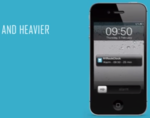Audi Creates Android App to Safe Battery Life
Posted in: UncategorizedHere’s an interesting addition to the “brands make products” trend. Audi, with help from DDB Spain is out with a mobile Android app called Start-Stop that mimics one of the features in new Audi vehicles; smart technology turns off the engine when not in use (at a stop light, etc.) and turns it back on when needed so that energy is saved.
The app monitors which apps have been running the longest in the background and sends an alert to remind the user to quit the app, thus saving valuable battery life.
It’s a perfect tie in with the brand and a practical and useful product all in one.
Havas’ Organic Revenue Fell 3.9% in U.S. in First Quarter
Posted in: UncategorizedHavas Group has reported organic growth of -0.9% for the first quarter of 2013, with group revenues of $504.44 million compared with $505.75 million for the same period last year.
North America was the worst-performing region, with a drop of 3.9%, which the company attributed in part to account losses including Dell at Arnold, and Sprint and Exxon at Havas Worldwide. However, healthcare still showed growth despite a big decline in Pfizer business. Organic growth excludes acquisitions and currency movements.
On a conference call with analysts, David Jones, the global CEO of Havas, spoke of a continued lack of visibility in the market, but predicted that Havas will return to growth by the second half of 2013. By then, last year’s big account losses will have “played through the system” by then and will no longer have a significant impact on quarter-on-quarter comparisons.
A internet transformou todo mundo em detetive?
Posted in: UncategorizedVocê já deve ter lido ou visto muitos filmes sobre detetives e investigações criminais, e aposto que já pensou em ser, pelo menos por um dia, um Sherlock Holmes, Tintim ou agente do CSI. Acontece que, ultimamente, a imaginação vem tomando formas reais, e muitas pessoas acabam se transformando em investigadores amadores com a ajuda da internet. Evidências desse fenômeno nos rodeiam diariamente e as consequências podem ser graves.
Mesmo que a escala de vigilância online seja pequena em nosso cotidiano, ao stalkear um ex-namorado ou a vida de um ídolo, por exemplo, muitas pessoas extrapolam padrões aceitáveis pela sociedade, e acabam, com a ajuda dos dispositivos e informações encontradas na web, ultrapassando limites legais. Suposições generalizadas levam civis a investigar outros civis até em busca de supostos criminosos.
Com essas investigações de sofá nascem vários questionamentos: Por que nos achamos no direito de vigiar outra pessoa? O preconceito e a discriminação não seriam altamente alimentados com esses atos? Existe um lado positivo nos detetives crowdsourcing? O que move essas pessoas?

Find Boston Bombers
Recentemente o tema atingiu seu auge por causa dos atentados em Boston. Depois que ninguém assumiu a responsabilidade do ataque, o FBI saiu à procura dos culpados e pediu para que as pessoas que tivessem tirado alguma foto ou filmado a maratona contribuíssem enviando material para investigação de possíveis suspeitos.
Fotos publicadas no 4chan e Reddit transformaram-se em supostas evidências, iniciando uma investigação crowdsourcing
É improvável que apenas uma imagem oriunda de um iPhone iria desvendar o caso, é claro. É necessário combinar vários materiais digitais para obter uma possível resposta eficiente. Eles usariam ferramentas biométricas – como reconhecimento facial -, softwares avançados e analíticos que ajudam a medir, minuciosamente, as características físicas de rosto e corpo à distância para rastrear algumas pistas através dessa junção de dados.
Ou seja, não seriam apenas fotos e vídeos de pessoas presentes na maratona que conseguiriam desvendar o crime. Também não seria simples olhada no material recolhido pela agência governamental nos arredores do local do atentado que revelaria o culpado. O trabalho é árduo e delicado. Ao pedir ajuda da população apenas para tentar acelerar o processo, o FBI perdeu o controle da situação.
As fotos enviadas para o FBI foram parar nas redes sociais e nos mais variados sites e fóruns de discussão. Começou então uma caçada virtual e uma especulação gigantesca. Inúmeras pessoas ligaram seu modo investigador e inciaram suas pesquisas por conta própria, numa espécie de CSI crowdsourcing.
Detetives amadores online representam perigo ao apontar culpados e convencer outras pessoas a acreditarem
Fotos publicadas no Instagram e no Facebook transformaram-se em supostas evidências das cenas de um crime, e principal matéria prima para os investigadores amadores. Também no Twitter, 4chan e Reddit uma grande quantidade de usuários comentavam as fotos e alegavam ter encontrado provas.
Com a hashtag findbostonbombers – e um diretório dedicado no Reddit, fechado posteriormente – eles apontavam suspeitos e identificavam pessoas através de roupas ou gestos, compartilhando as informações até que, mesmo sem certeza, uma dessas fotos foi parar na capa do New York Post acusando dois homens.

Caça às bruxas online

Não estamos discutindo aqui como o FBI encontrou os suspeitos e realizou as perseguições e prisões que se desenrolaram depois. O ponto é, como pessoas bem ou mal intencionadas, juntamente com o poder das redes sociais, conseguiram levar uma foto “investigativa” de um atentado para a primeira página de um grande jornal americano, menos de 48 horas depois do acontecimento.
A chamada de capa “Bag man”, do New York Post, foi um dos maiores exemplos de como a a internet está pautando os meios de comunicação nos últimos anos, com falta de apuração e, principalmente, sem citar o perigo que os detetives amadores representam ao apontar culpados e convencer outras pessoas a acreditarem nisso.
Publicar foi um erro terrível, uma vez que a foto não foi divulgada por nenhum órgão oficial e sim um trabalho feito por vigilantes da internet. Sempre há potencial dessas imagens serem manipuladas com Photoshop, sem contar os “detetives” com alguma coisa causa ou ativismo, que podem tentar empurrar as investigações em uma determinada direção. Tratando, dessa forma, um caso de extrema delicadeza com viés a favor de alguma motivação ou preconceito.
A imagem publicada era de dois homens em roupas de trilha – um com uma mochila preta – ambos pareciam ser de descendência árabe, destacados por usuários do 4chan e Reddit como potenciais suspeitos. Representantes do Reddit mais tarde pediram desculpas pela caça às bruxas on-line, solicitando aos usuários serem sensíveis com o poder que tem nas redes sociais. Mas nem o NY Post nem qualquer meio de comunicação que compartilharam a foto se desculparam oficialmente por publicarem falsas notícias e espalharem desinformação.

De onde vem?
Segundo o mestre em filosofia e estudioso do assunto, Thiago Borges, essas investigações amadoras são oriundas da década de 1990, onde com poucos usuários comparados aos dias atuais, a internet ainda era um lugar dos aficionados por computadores. Os mecanismos de busca contavam com códigos de busca rudimentares e o acesso ao conteúdo era na maioria das vezes restrito.
“Naquele momento de poucos vídeos e imagens, não era raro se deparar com sites sobre ‘teorias da conspiração’ e seus propagadores. Fóruns de discussão que agregavam as notícias da mídia e seus relacionamentos com grupos. Toda ‘comprovação’ era realizada a partir de evidencias como elementos gráficos da cédula do dólar até interpretações de discursos de autoridades em busca de mensagens subliminares. Era possível rastrear estas improváveis ligações nestes sites e acompanhar as atualizações do movimento conspiratório ao redor do globo a partir da mídia convencional”, lembra Thiago.
Neste primeiro momento a internet era o lugar de detetives que varriam a rede em busca de novas provas que endossassem estas teorias. O mercado ainda não enxergava o público da internet como alvo, não havia marketing voltado para estes fãs de computador e programação. Era possível encontrar “hackers” nas salas de IRC, fazer novas amizades para conversar sobre estas teorias, aprender novas tecnologias para avançar em busca da verdade, e, em poucos cliques depois, trocar impressões sobre episódios de “Star Trek” que ainda não tinham sido exibidos no Brasil.
Hoje em dia, pessoas interessadas em desvendar mistérios e supostas conspirações estão aproveitando das ferramentas atuais – smartphones com GPS, câmeras de alta definição, conexão em tempo integral, excesso de exposição online, etc – para se transformarem em verdadeiros detetives. Muitas não percebem o que está em jogo e como inocentes podem sofrer consequências com isso. Nós não somos heróis.
Casos como o de Boston retrocedem as conquistas que prometem democratizar a informação e distribuir conhecimento para todos
A internet, de forma geral, é exemplo de diversos movimentos sociais interessantes – como a Primavera Árabe e o Occupy Wall Sreet – e desafiadores para o bem. Casos como o de Boston retrocedem as conquistas que prometem democratizar a informação e distribuir conhecimento para todos.
Se muitas pessoas tem tempo e vontade de investigar casos criminais, elas deveriam dedicar esse mesmo tempo e energia para não alimentar mais especulações que geram uma bola de neve de informações falsas. Os meios de comunicação e os órgãos oficiais podem incentivar a ética e a regulamentação a partir de exemplos próprios.
É hora da grande maioria desses detetives amadores online e de toda a sociedade canalizarem suas energias para pensar como vamos viver ao lado dessas ferramentas atuais, utilizando-as para os fins corretos, já que hoje em dia é inevitável controlar a força da internet diante de casos de comoção popular.
 Post originalmente publicado no Brainstorm #9
Post originalmente publicado no Brainstorm #9
Twitter | Facebook | Contato | Anuncie
Digitas Unveils Tool to Find YouTube Stars Before They’re Stars
Posted in: UncategorizedBrands have been working with YouTube stars — iJustine, Shay Carl, Michelle Phan and the like — for years, but what if you could identify a not-yet star before they got big?
That’s the idea behind “Emerging Talent Tracker,” a new tool developed Publicis Groupe’s Digitas and startup Outrigger Media, announced today at their NewFront presentation for advertisers.
Outrigger’s analytics platform OpenSlate tracks 50,000 channels and 25 million videos on YouTube and assigns them a score based on their engagement with their audience, how frequently they produce new content and their influence. YouTube producers with relatively small audiences can have high scores, allowing advertisers to access the long tail of YouTube talent.
Instagram’s New Feature Lets Brands ‘Tag’ Consumers in Photo Stream
Posted in: UncategorizedThere’s still no advertising on Instagram, but a new photo-tagging feature offers marketers new tricks to vie for users’ attention.
Dubbed “Photos of You,” the feature lets you tag other Instagram users, whether they’re people or brands, directly in photos. It functions similarly to photo tagging on Facebook, Instagram’s corporate parent. Previously, Instagram users who wanted to link another user to their photo would take the Twitter-like approach of @-mentioning them in the attached text.
The key difference is that tagging will now create an archive of photos that can be viewed on any user’s profile — provided they’ve granted permission for them to appear there. Wary of the blowback Facebook has been subject to over the years because of party photos inadvertently becoming visible to parents and prospective employers, Instagram has built controls into “Photos of You” that let users manually choose which tagged photos will be visible to others.
Diet Coke’s Vending Machine Goes on a Diet
Posted in: UncategorizedWhen the bottles are so sleek, shouldn’t the vending machine be too? Ogilvy Paris and Diet Coke team up to design a “Slender Vender” — an elegant-looking vending machine that was inspired by the aluminum bottles the soda comes packaged in.
For more exciting ideas in brand creativity, check out Creativity-Online.com, follow @creativitymag on Twitter or sign up for the Creativity newsletter.
Little Debbie’s Logo Change Is So Subtle, It Becomes a Spot the Difference Game
Posted in: Uncategorized
Little Debbie did not consult with Gap, JCPenney or any other noted logo overhaulers before updating its own logo—the first tweak to the design since 1985. The change is remarkably subtle, so much so that the dessert-snacks brand is challenging its fans on Facebook to see how many differences they can find. "Leave a comment with the changes you can spot, and share it with your friends to see how keen their eyes are," the brand says. For hints, check out the 1,200 comments left so far.
UPDATE: Below, check out the original 1959 photo of Debbie McKee, and the first logo, from 1960, which was based on the photo.

![]()
Employees Get Tattoos of Company’s Logo in Exchange for 15 Percent Raises
Posted in: Uncategorized
Get scarred for life for a little extra cash! That's the tempting offer being floated by New York City's Rapid Realty, which is offering employees 15 percent raises if they get the company's logo tattooed on their person. Some 40 employees have already done so—either because they love the firm, need the money, or both. "I was like, Why am I throwing my money away when I could get myself from $25,000 to $40,000 for the same amount of work?" Stephanie Barry, who might not understand what 15 percent means, tells CBS News. "My wife was a little concerned but I said, you know what, it was the best commitment I could think of," said another employee, who's been on the job all of one month. There are no size or placement restrictions—one clearly ashamed employee got a tiny tattoo behind her ear. And actually, the design isn't terrible. Rapid Realty owner Anthony Lolli pays for the tattoos, which cost up to $300 each. But tellingly, he has yet to get one himself.
![]()
Of Course Hyundai Knew Its Ad Would Offend — Mountain Dew Too
Posted in: UncategorizedI’m getting tired of so many offensive ads showing up online that companies later apologize for, often claiming they neither knew about them nor approved them. I don’t believe their apologies are sincere, and I wonder if you do.
I think Hyundai Europe — and probably PepsiCo’s Mountain Dew, Ford India and others that deny or regret ads that have already delivered their marketing messages — knew full well that its controversial “Pipe Job” video existed.
Wolfs Law – The Joy Formidable
Posted in: UncategorizedLe trio de musiciens gallois « The Joy Formidable » nous présente le clip illustrant le morceau Wolf’s Law avec des images très impressionnantes. Tout en noir & blanc, ces images de vie et de nature proposée par PD3 nous montre toute la beauté de la Terre, permettant par la même occasion de souligner la beauté du morceau.
This App Will Get Your Ass Out of Bed
Posted in: UncategorizedCan’t wake up in the morning? There’s an app for that. No, not your builtin, boring alarm app; an app that will play increasingly “harder” music if you don’t respond to the initial soft nudges.
Created by JWT Brazil for radio station 91 Rock, the song that finally does awaken the heavy sleeper can be shared with the user’s social followers.
Meet the Brooklyn Agency That White-Labels Clothing for Big Marketers
Posted in: UncategorizedIf alternative marketing agency Vice and white-label clothier Li & Fung birthed an offspring, it would be Greenpoint, Brooklyn-based brand-development firm the Supply System.
Launched in 2010, founders Alexander Keith and Adam Travis want to make it easier for mass brands to sell cool clothes. The shop has grown its client roster to more than 50 companies over the past few years to include big names such as Urban Outfitters, Amazon and Need Supply.
Those names are a long way from where the Supply System got its start, which was as a traveling showroom of sorts. Mr. Keith, whose background is at branding agencies and who at one point worked at Wolff Olins, and Mr. Travis, a production manager, initially stocked a van full of made-in-Brooklyn garments and accessories that they sold to boutiques across the country.
Carvel’s Fudgie the Whale Returns As Spokesman
Posted in: UncategorizedWay back in the day, ice cream cake maker Carvel marketed a cake called Fudgie the Whale. Just as you might assume, it was a chocolate cake shaped like a whale.
Today, the brand has resurrected Fudgie the Whale in the form on an animated spokesman. In two new Focus Brands-created commercials, Fudgie can be seen touting the brand’s two for one Wednesday Sundae special and specially designed Mother’s Day cakes.
Old Fudgie the Whale commercial:
Bacardi USA Shifts Media Duties to Mindshare
Posted in: UncategorizedSpirits marketer Bacardi USA has moved digital and traditional media-planning and buying to WPP’s Mindshare from KSL, as the company’s new management team continues to shake up the agency roster, according to industry executives.
In the U.S., Bacardi spent $83.9 million on measured media last year, according to Kantar Media. But overall estimated spending on the business –which includes traditional media and digital media planning and buying– is estimated at around $130 million.
KSL, an independent agency, defended the account after the review was launched in January. It’s a tough loss for the shop, which had a long-standing relationship with the marketer, gaining more work in 2010 when Bacardi consolidated most of its brands with the agency.
Bacardi Shifts Media Duties to Mindshare
Posted in: UncategorizedGlobal spirits marketer Bacardi Limited has moved digital and traditional media-planning and buying to WPP’s Mindshare from KSL, as the company’s new management team continues to shake up the agency roster, according to industry executives.
In the U.S., Bacardi spent $83.9 million on measured media last year, according to Kantar Media. But overall estimated spending on the business –which includes traditional media and digital media planning and buying– is estimated at around $130 million.
KSL, an independent agency, defended the account after the review was launched in January. It’s a tough loss for the shop, which had a long-standing relationship with the marketer, gaining more work in 2010 when Bacardi consolidated most of its brands with the agency.
Disney Interactive NewFront: New Shows, Vevo Pact and ‘Story’ App for Your Photos
Posted in: UncategorizedDisney Interactive turned up the volume on its NewFront presentation to ad buyers this year, moving to a bigger venue and closing with a performance from the band Plain White Ts.
Last year, the division of Walt Disney had recently acquired the Babble.com mommy blog and struck a deal to collaborate on family-friendly Disney.com and YouTube videos. At this year’s event on Thursday morning, it announced two new initiatives: a partnership with Vevo for a family-friendly music entertainment experience and a new app called Story, which turns video, photos and music captured on smartphones into shareable “stories.”
The NewFronts are digital publishers’ attempt to win more ad dollars — ideally from fat TV budgets — by imitating the TV industry’s annual upfront pitches and negotiations.







































